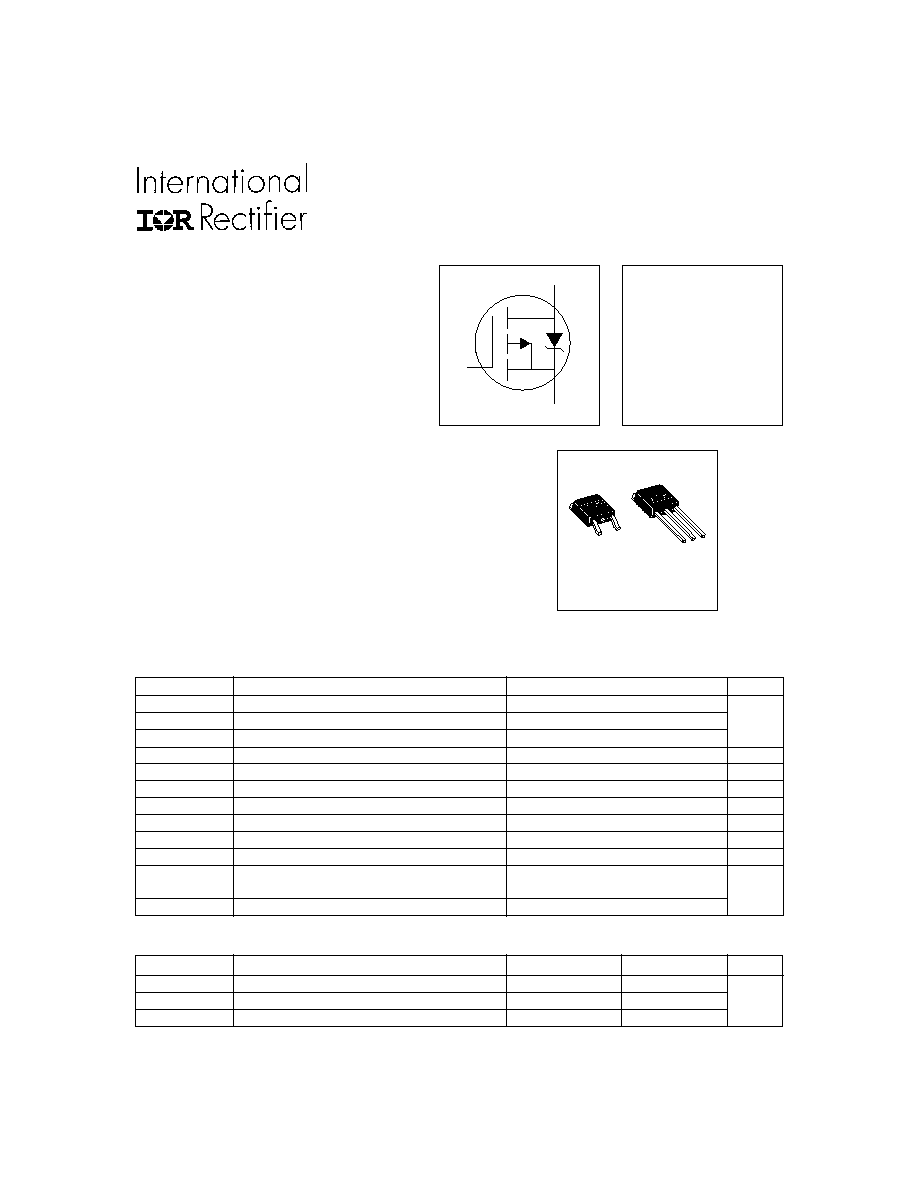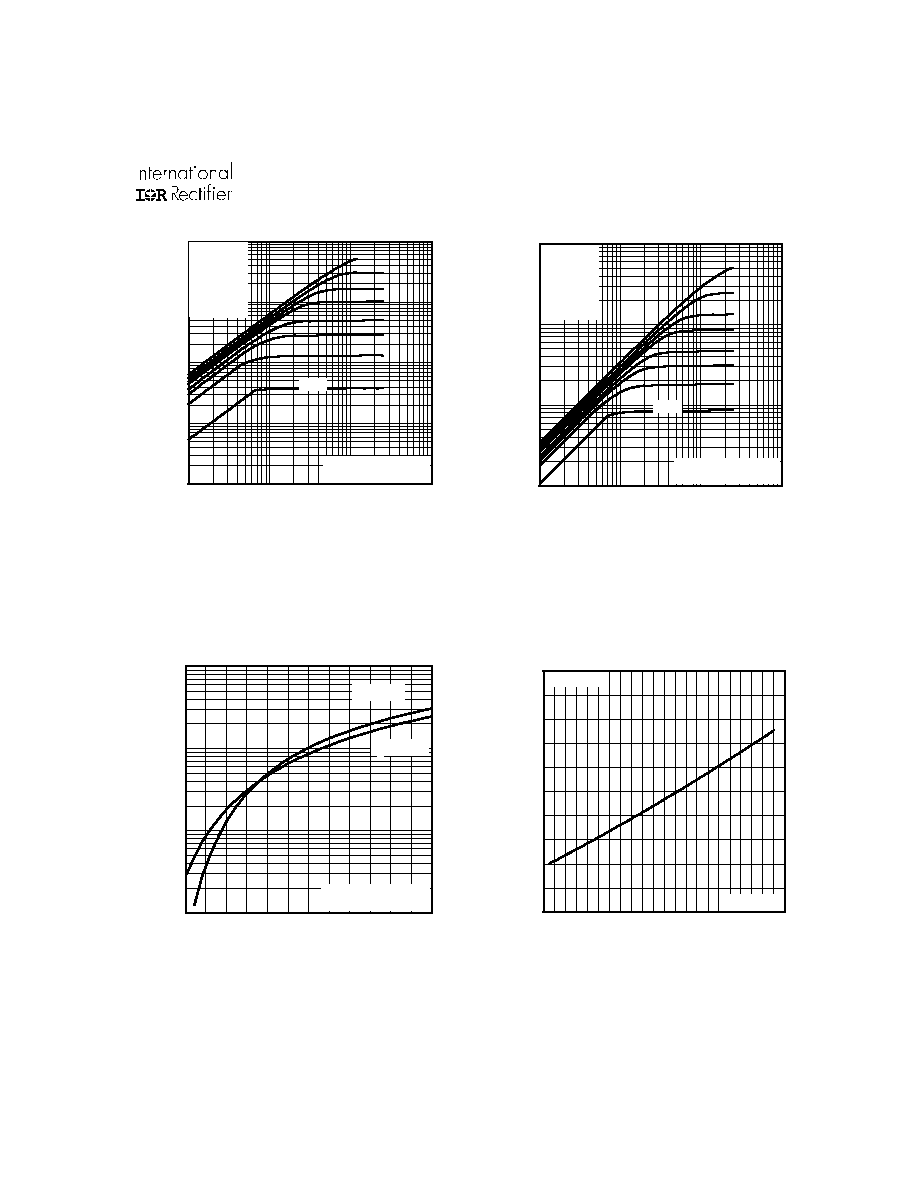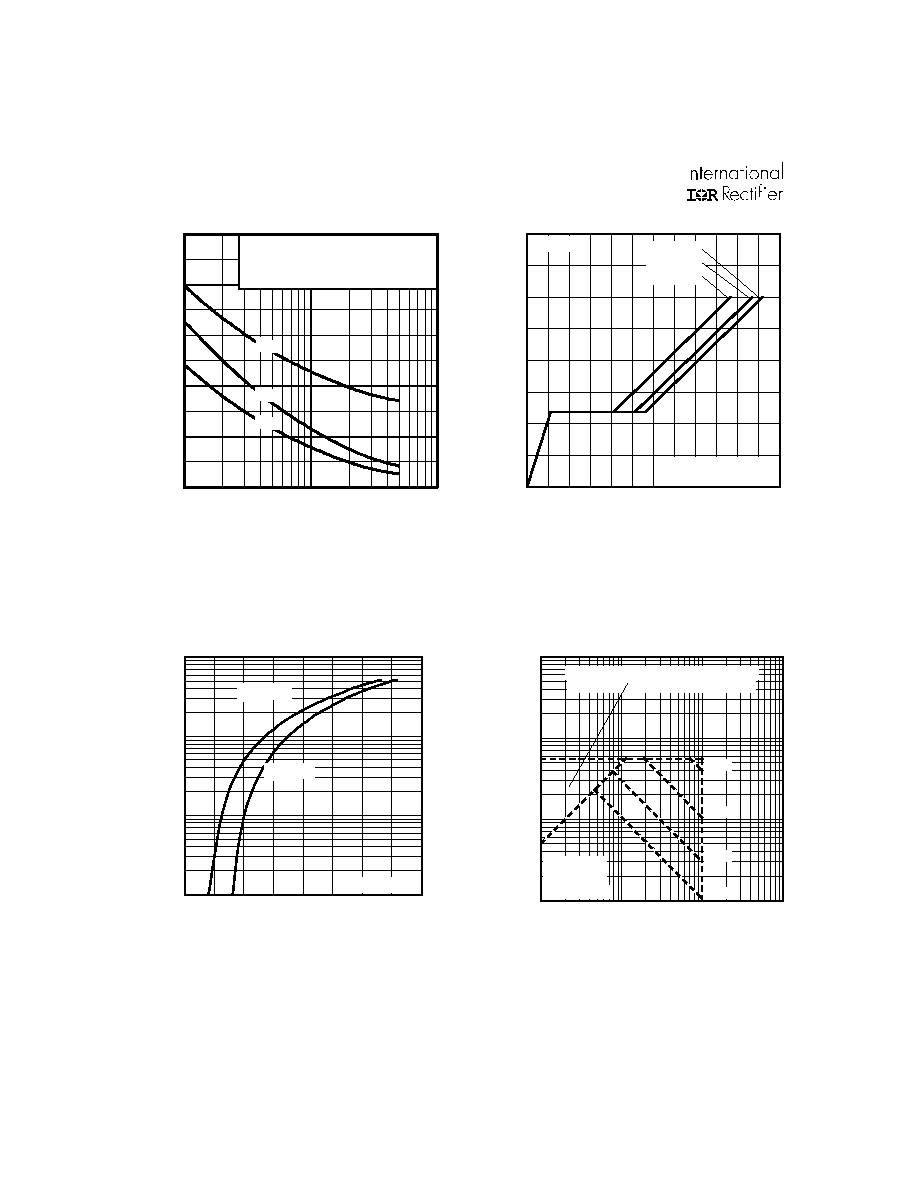Äîêóìåíòàöèÿ è îïèñàíèÿ www.docs.chipfind.ru

IRFR/U5410
HEXFET
®
Power MOSFET
V
DSS
= -100V
R
DS(on)
= 0.205W
I
D
= -13A
5/3/99
Parameter
Typ.
Max.
Units
R
qJC
Junction-to-Case
1.9
R
qJA
Junction-to-Ambient (PCB mount)**
50
°C/W
R
qJA
Junction-to-Ambient
110
Thermal Resistance
D-Pak
TO-252AA
I-Pak
TO-251AA
l
Ultra Low On-Resistance
l
P-Channel
l
Surface Mount (IRFR5410)
l
Straight Lead (IRFU5410)
l
Advanced Process Technology
l
Fast Switching
l
Fully Avalanche Rated
Description
Parameter
Max.
Units
I
D
@ T
C
= 25°C
Continuous Drain Current, V
GS
@ -10V
-13
I
D
@ T
C
= 100°C
Continuous Drain Current, V
GS
@ -10V
-8.2
A
I
DM
Pulsed Drain Current
-52
P
D
@T
C
= 25°C
Power Dissipation
66
W
Linear Derating Factor
0.53
W/°C
V
GS
Gate-to-Source Voltage
± 20
V
E
AS
Single Pulse Avalanche Energy
194
mJ
I
AR
Avalanche Current
-8.4
A
E
AR
Repetitive Avalanche Energy
6.3
mJ
dv/dt
Peak Diode Recovery dv/dt
-5.0
V/ns
T
J
Operating Junction and
-55 to + 150
T
STG
Storage Temperature Range
Soldering Temperature, for 10 seconds
300 (1.6mm from case )
°C
Absolute Maximum Ratings
Fifth Generation HEXFETs from International Rectifier
utilize advanced processing techniques to achieve
extremely low on-resistance per silicon area. This benefit,
combined with the fast switching speed and ruggedized
device design that HEXFET Power MOSFETs are well
known for, provides the designer with an extremely efficient
and reliable device for use in a wide variety of applications.
The D-Pak is designed for surface mounting using vapor
phase, infrared, or wave soldering techniques. The straight
lead version (IRFU series) is for through-hole mounting
applications. Power dissipation levels up to 1.5 watts are
possible in typical surface mount applications.
S
D
G
PD - 9.1533A
www.irf.com
1

IRFR/U5410
2
www.irf.com
Source-Drain Ratings and Characteristics
Parameter
Min. Typ. Max. Units
Conditions
I
S
Continuous Source Current
MOSFET symbol
(Body Diode)
showing the
I
SM
Pulsed Source Current
integral reverse
(Body Diode)
p-n junction diode.
V
SD
Diode Forward Voltage
-1.6
V
T
J
= 25°C, I
S
= -7.8A, V
GS
= 0V
t
rr
Reverse Recovery Time
130 190
ns
T
J
= 25°C, I
F
= -8.4A
Q
rr
Reverse Recovery Charge
650 970
nC
di/dt = 100A/µs
t
on
Forward Turn-On Time
Intrinsic turn-on time is negligible (turn-on is dominated by L
S
+L
D
)
-13
-52
A
Notes:
** When mounted on 1" square PCB (FR-4 or G-10 Material ) .
For recommended footprint and soldering techniques refer to application note #AN-994
This is applied for I-PAK, L
S
of D-PAK is measured between
lead and center of die contact
Starting T
J
= 25°C, L = 6.4mH
R
G
= 25W, I
AS
= -7.8A. (See Figure 12)
Repetitive rating; pulse width limited by
max. junction temperature. ( See fig. 11 )
I
SD
£ -7.8A, di/dt £ 200A/µs, V
DD
£ V
(BR)DSS
,
T
J
£ 150°C
Pulse width £ 300µs; duty cycle £ 2%.
S
D
G
Parameter
Min. Typ. Max. Units
Conditions
V
(BR)DSS
Drain-to-Source Breakdown Voltage
-100
V
V
GS
= 0V, I
D
= -250µA
DV
(BR)DSS
/DT
J
Breakdown Voltage Temp. Coefficient -0.12
V/°C Reference to 25°C, I
D
= -1.0mA
R
DS(on)
Static Drain-to-Source On-Resistance
0.205
W
V
GS
= -10V, I
D
= -7.8A
V
GS(th)
Gate Threshold Voltage
-2.0
-4.0
V
V
DS
= V
GS
, I
D
= -250µA
g
fs
Forward Transconductance
3.2
S
V
DS
= -50V, I
D
= -7.8A
-25
µA
V
DS
= -100V, V
GS
= 0V
-250
V
DS
= -80V, V
GS
= 0V, T
J
= 150°C
Gate-to-Source Forward Leakage
100
V
GS
= 20V
Gate-to-Source Reverse Leakage
-100
nA
V
GS
= -20V
Q
g
Total Gate Charge
58
I
D
= -8.4A
Q
gs
Gate-to-Source Charge
8.3
nC
V
DS
= -80V
Q
gd
Gate-to-Drain ("Miller") Charge
32
V
GS
= -10V, See Fig. 6 and 13
t
d(on)
Turn-On Delay Time
15
V
DD
= 50V
t
r
Rise Time
58
I
D
= -8.4A
t
d(off)
Turn-Off Delay Time
45
R
G
= 9.1W
t
f
Fall Time
46
R
D
=6.2W, See Fig. 10
Between lead,
6mm (0.25in.)
from package
and center of die contact
C
iss
Input Capacitance
760
V
GS
= 0V
C
oss
Output Capacitance
260
pF
V
DS
= -25V
C
rss
Reverse Transfer Capacitance
170
= 1.0MHz, See Fig. 5
nH
Electrical Characteristics @ T
J
= 25°C (unless otherwise specified)
L
D
Internal Drain Inductance
L
S
Internal Source Inductance
I
GSS
ns
4.5
7.5
I
DSS
Drain-to-Source Leakage Current
S
D
G
Uses IRF9530N data and test conditions.

IRFR/U5410
www.irf.com
3
Fig 4. Normalized On-Resistance
Vs. Temperature
Fig 2. Typical Output Characteristics
Fig 1. Typical Output Characteristics
Fig 3. Typical Transfer Characteristics
0.01
0.1
1
10
100
0.1
1
10
100
20µs PULSE WIDTH
T = 25 C
J
°
TOP
BOTTOM
VGS
-15V
-10V
-8.0V
-7.0V
-6.0V
-5.5V
-5.0V
-4.5V
-V , Drain-to-Source Voltage (V)
-
I
,
D
r
ai
n-
t
o
-
S
our
ce C
u
r
r
ent
(
A
)
DS
D
-4.5V
0.1
1
10
100
0.1
1
10
100
20µs PULSE WIDTH
T = 150 C
J
°
TOP
BOTTOM
VGS
-15V
-10V
-8.0V
-7.0V
-6.0V
-5.5V
-5.0V
-4.5V
-V , Drain-to-Source Voltage (V)
-
I
,
D
r
ai
n-
t
o
-
S
our
ce C
u
r
r
ent
(
A
)
DS
D
-4.5V
0.1
1
10
100
4
5
6
7
8
9
10
V = 10V
20µs PULSE WIDTH
DS
-V , Gate-to-Source Voltage (V)
-I , Drain-to-Source Current (A)
GS
D
T = 25 C
J
°
T = 150 C
J
°
-60 -40 -20
0
20
40
60
80 100 120 140 160
0.0
0.5
1.0
1.5
2.0
2.5
T , Junction Temperature ( C)
R
, D
r
a
i
n
-
to
-S
o
u
r
c
e
O
n
R
e
s
i
s
t
a
n
c
e
(
N
or
m
a
l
i
z
ed)
J
D
S
(on)
°
V
=
I =
GS
D
-10V
-14A

IRFR/U5410
4
www.irf.com
Fig 8. Maximum Safe Operating Area
Fig 6. Typical Gate Charge Vs.
Gate-to-Source Voltage
Fig 5. Typical Capacitance Vs.
Drain-to-Source Voltage
Fig 7. Typical Source-Drain Diode
Forward Voltage
0.1
1
10
100
0.2
0.8
1.4
2.0
2.6
-V ,Source-to-Drain Voltage (V)
-
I
,
R
e
ver
s
e D
r
ai
n C
u
r
r
ent
(
A
)
SD
SD
V = 0 V
GS
T = 25 C
J
°
T = 150 C
J
°
0
400
800
1200
1600
2000
1
10
100
C
,
Ca
pa
c
i
t
a
n
c
e (
p
F)
A
DS
-V , Drain-to-Source Voltage (V)
V = 0V, f = 1MHz
C = C + C , C SHORTED
C = C
C = C + C
GS
iss gs gd ds
rss gd
oss ds gd
C
iss
C
oss
C
rss
0
10
20
30
40
50
60
0
5
10
15
20
Q , Total Gate Charge (nC)
-V , Gate-to-Source Voltage (V)
G
GS
FOR TEST CIRCUIT
SEE FIGURE
I =
D
13
-8.4A
V
=-20V
DS
V
=-50V
DS
V
=-80V
DS
1
10
100
1000
1
10
100
1000
OPERATION IN THIS AREA LIMITED
BY R
DS(on)
Single Pulse
T
T
= 150 C
= 25 C
°
°
J
C
-V , Drain-to-Source Voltage (V)
-I
,
D
r
ai
n C
u
rrent
(A
)
I
,
D
r
ai
n C
u
rrent
(A
)
DS
D
10us
100us
1ms
10ms

IRFR/U5410
www.irf.com
5
Fig 11. Maximum Effective Transient Thermal Impedance, Junction-to-Case
Fig 9. Maximum Drain Current Vs.
Case Temperature
Fig 10a. Switching Time Test Circuit
Fig 10b. Switching Time Waveforms
V
DS
-10V
Pulse Width £ 1 µs
Duty Factor £ 0.1 %
R
D
V
GS
V
DD
R
G
D.U.T.
+
-
V
DS
90%
10%
V
GS
t
d(on)
t
r
t
d(off)
t
f
25
50
75
100
125
150
0
3
6
9
12
15
T , Case Temperature ( C)
-I , Drain Current (A)
°
C
D
0.01
0.1
1
10
0.00001
0.0001
0.001
0.01
0.1
1
Notes:
1. Duty factor D = t / t
2. Peak T = P
x Z
+ T
1
2
J
DM
thJC
C
P
t
t
DM
1
2
t , Rectangular Pulse Duration (sec)
Thermal Response
(Z )
1
th
J
C
0.01
0.02
0.05
0.10
0.20
D = 0.50
SINGLE PULSE
(THERMAL RESPONSE)




